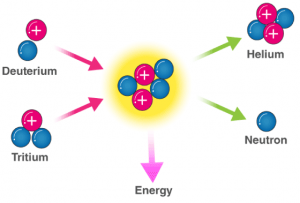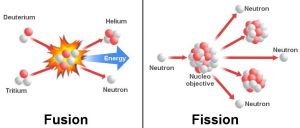Nuclear fusion
Nuclear fusion is the reaction that happens when two or more atomic nuclei are combined, and form one or more different atomic nuclei and subatomic particles (neutrons or protons).
It takes considerable energy to force nuclei to fuse, even those of the lightest element, hydrogen. When accelerated to high enough speeds, nuclei can overcome this repulsion, and be brought close enough such that the attractive force is greater than the repulsive force. The strong force grows rapidly once the nuclei are close enough, and the fusing nucleons can essentially "fall" into each other, resulting in the energy produced.
- The fusion of lighter nuclei, which creates a heavier nucleus, generally releases more energy than it takes to force the nuclei together.
Energy released in most nuclear reactions is much larger than in chemical reactions, because the binding energy that holds a nucleus together is greater than the energy that holds electrons to a nucleus.
Only the collision of matter and antimatter is more energetic per unit of mass than nuclear fusion.
The act of nuclear fusion powers stars of all or all-known magnitudes.
The event of a supernova can produce enough energy to fuse nuclei into elements heavier than iron.
On Earth, laboratory fusion of hydrogen isotopes was accomplished in 1932.
Research into fusion for military purposes began in the early 1940s, and
self-sustaining nuclear fusion was first carried out in 1952 in the form of the first hydrogen bomb test.

